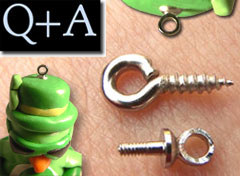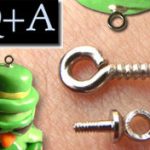
Charm Jewelry Findings for Hanging Miniature Polymer Clay Sculptures
How to make charms out of your Fimo clay and Sculpey projects:
More...
Q: I’m not sure if you can answer this, and I had no clue where to post it on the forums! For some reason, I seem to be unable to find any information to tell this newbie how you affix clasps and things to the string! Silly thing, I know! I have a wonderful cute penguin charm I made from clay and I’d like to wear him! Thanks! ~Michelle
A: Hi Michelle. Since yesterday’s post had a penguin theme to do with polymer clay kids crafts and teacher resources, I just had to respond to your question here today.
Small sculpted clay pieces (especially penguins:) make great charms and pendants. To turn them into something that can hang from a necklace or clip you will first need to add a finding to it.
If your clay item has a hole in it like a bead does, you can use what is called a head pin to convert it into a charm. A head pin is basically a piece of wire that has a head on it, like a straight pin does. It is quite flexible and easy to bend.
What you do is slide the head pin into the hole of the bead, with the head on the bottom and the rest of the pin sticking out the top. The part that sticks out is then formed into a loop using round nose pliers. If the loop is big enough, you can run your necklace though it, otherwise you will need to add a jump ring or a bail to the loop.
If your charm, does not have a hole in it, you can use a small screw eye like the ones pictured above in the photo.
The smaller one pictured is approximately 5/16" long and the hole or ring measures about 1/8". It has a nice silver finish, but you can also find them in gold. They are available in the jewelry section of most craft stores.
The larger one, which is still tiny at 3/8", can often be found in the hardware store or the woodworking section of a craft store.
You will first need to drill a tiny ‘pilot’ hole before twisting in the screw eye… or the pendant / charm may crack. Always drill an ‘undersized’ hole, so the screw threads still have something to grab onto.
To add the clasps to the ends of a necklace, there are a few different ways to do that depending on the material you are using. There are so many techniques, in fact, that I will have to make some demo videos in the future to explain them all.
Hopefully these quick tips about polymer clay charm jewelry findings will help point you in the right direction, Michelle. Let me know how it works out with your miniature penguin sculpture. And if you have follow up questions or if something wasn’t clear, feel free to use the comments section below to chat further.
Sponsored Ads & Special Promotions


Want to chat about today’s post? That’s what the comment section below is for. Scroll Down… We’d love to hear from you!
Or... if you would like to request a topic for a future post, here is the link to do that… PcT Suggestion Box

Sure Marsha… that’s a good idea! If it is loose after baking, just glue it in with Krazy Glue.
Could you insert the screw eye before baking the bead?
Good suggestion Beth! Brass has had a resurgence lately and would make a perfect addition to jewelry charms!
I love this article and have a tip for using brass eye screws . They offer a different look and are always available. they also look nice with copper wires on your earrings. Thanks again Beth
I agree MJ! A little drop of Krazy glue or its equivalent would be an excellent idea!
Cindy,
What great idea to use those small eye screws!! I would be inclined to use a small amount of glue on the threads to prevent it coming loose. What you think?
You are very welcome Michelle!!
Thanks so much for taking the time to answer that. It helped me bunches!